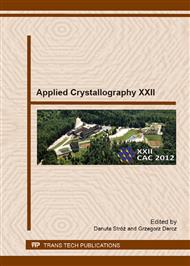p.319
p.323
p.327
p.331
p.335
p.339
p.343
p.347
p.351
Structure and Resistance to Electrochemical Corrosion of NiTi Alloy
Abstract:
The NiTi alloy (50.6 at.% Ni) passivated for 30 min at 130°C by autoclaving has been studied towards corrosion resistance in aqueous solutions of 3% NaCl, 0.1 M H2SO4, 1 M H2SO4 and HBSS. Structure and thickness of the passive layer (TiO2, rutile) were examined by X-ray reflectivity method and high resolution electron microscopy. Corrosion behavior of this oxide layer was investigated by open circuit potential method and polarization curves. It was found that the corrosion resistance of the passivated NiTi alloy is strongly dependent on the type of corrosive environment. The higher corrosion resistance of the tested samples was revealed in sulfate solutions as compared to chloride ones. The highest resistance to electrochemical corrosion of the NiTi alloy was observed in 0.1 M H2SO4 solution. Susceptibility to pitting corrosion of the tested samples was observed which increased with the concentration rise of chlorine anions in solution. Electrochemical tests for 316L stainless steel carried out under the same experimental conditions revealed a weaker corrosion resistance in all solutions as compared to the highly corrosion resistant NiTi alloy.
Info:
Periodical:
Pages:
335-338
Citation:
Online since:
June 2013
Keywords:
Price:
Сopyright:
© 2013 Trans Tech Publications Ltd. All Rights Reserved
Share:
Citation:


